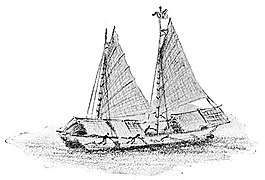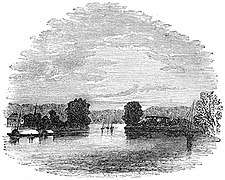Casco (barge)
Casco were flat-bottomed square-ended barges from the Philippines. They were used mostly to carry cargo along lakes and rivers, and as lighters to transport goods to and from moored ships.[1] They were built similar to a sampan with two detachable masts with junk rigs made of woven fiber. The entire deck is covered almost entirely in removable curving panels.[2][3]
Cascos were most prevalent in southern Luzon. Particularly along the Pasig River and Laguna de Bay, as well as in the Manila Bay harbor.[2][3] In the late 18th and early 19th centuries, they were often strung together in a train drawn by a steamship (vapor). They were used as transport ships by American troops in Laguna de Bay during the Philippine-American War.[4] Cascos are still used today in fluvial parades. An example is during the celebrations of Our Lady of Peñafrancia in Naga City, Bicol.[5]
.jpg)

_in_Manila_Bay_(1906).jpg)

See also
| Wikimedia Commons has media related to Casco. |
References
- ↑ Ricardo E. Galang (1941). "Types of Watercraft in the Philippines". The Philippine Journal of Science. 75 (3): 291&ndash, 306.
- 1 2 John Foreman (1906). The Philippine Islands: A Political, Geographical, Ethnographical, Social and Commercial History of the Philippine Archipelago embracing the Whole Period of Spanish Rule with an Account of the Succeeding American Insular Government. Hazell, Watson and Viney, LD.
- 1 2 Campbell Dauncey (1906). An Englishwoman in the Philippines. E.P. Dutton & Company.
- ↑ Arnaldo Dumindin (2006). "Philippine-American War, 1899-1902". Retrieved 1 July 2018.
- ↑ Insight Guides Philippines. Rough Guides UK. 2018. ISBN 9781786718563.